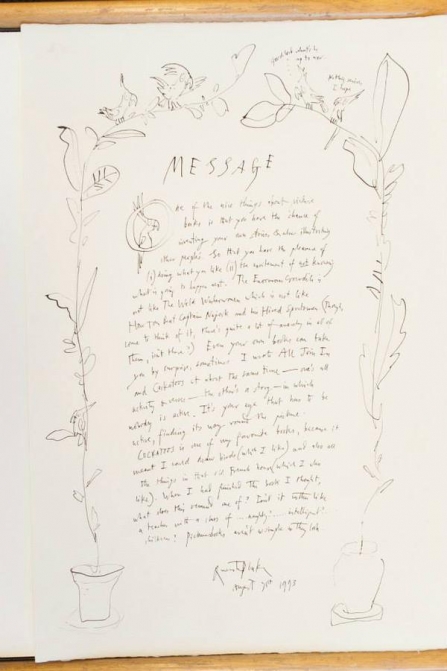
Authors' letters found at Reading University
Friday 6th March 2015
Rarely-seen original letters and drawings lost at the back of a cupboard
The small collection, which includes beautifully sketched answers from former Children's Laureates Quentin Blake and Anthony Browne, and Shirley Hughes, was found in a store cupboard during the relocation of literature to the University’s new Learning Hub. The 'answers' were received from nine children's authors in 1993, responding to a letter from the University's Reading and Language Information Centre asking for a list of books they would recommend to children who were marooned on a desert island. Although the authors’ picks are wide-ranging, it’s the iconic Treasure Island by R.L Stevenson that tops the list with three recommendations.
Although Quentin Blake doesn’t name his desert island books his illustration offers a fascinating insight into the joy of being an illustrator - both illustrating your own works and those written by other people. Quentin picks Cockatoos as the favourite book he worked on because ‘it meant I could draw birds (which I like) and also all the things in that old French house (which I also like)’. Appropriately linking it to the Institute of Education, he likens the story to '..a teacher with a class of … naughty ?… intelligent?... children'. He also reminds us that ‘picture books aren’t as simple as they look.’
Karen Goulding, Director of the University’s Learning Hub and who found the collection, said: “It was a wonderful surprise – our own C.S Lewis magical wardrobe moment. Although we can’t be certain, it’s likely that these letters and illustrations that hold the hand-written musings from some of the UK’s best authors, have only been seen by a handful of people.'
The collection was displayed during the official opening of the Learning Hub in March 2015. This unique resource gives trainee teachers and schools the tools to provide children with the very best in literacy teaching and development.
The University plans to put the collection on public display in the near future.
Read the full article here, on the IoE pages of the University of Reading website